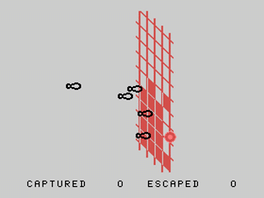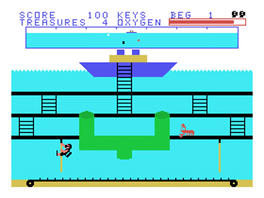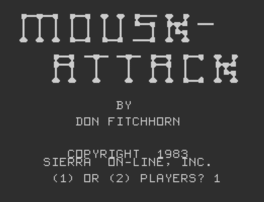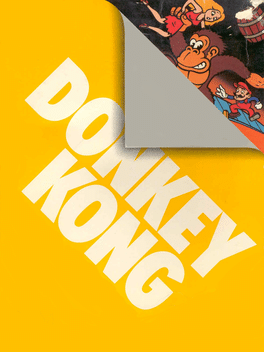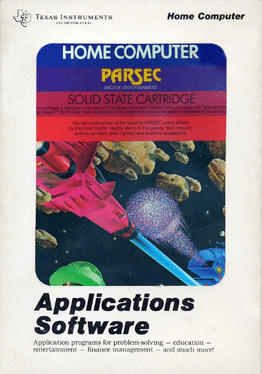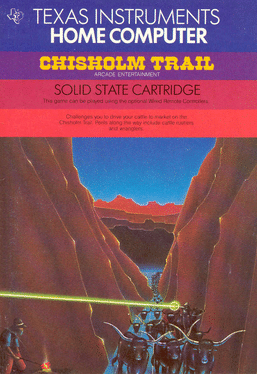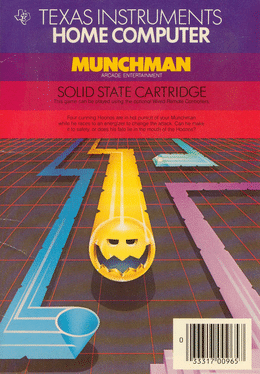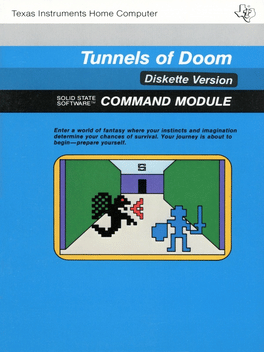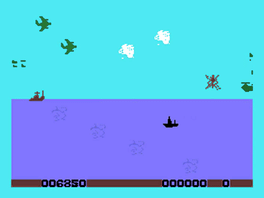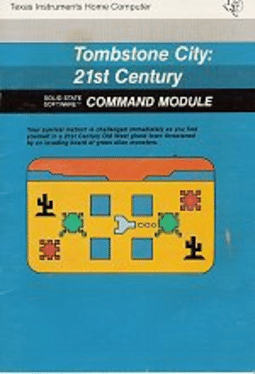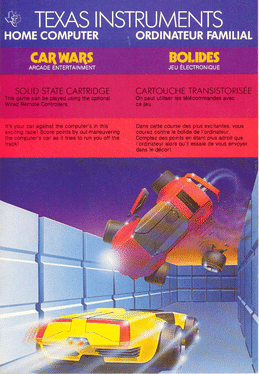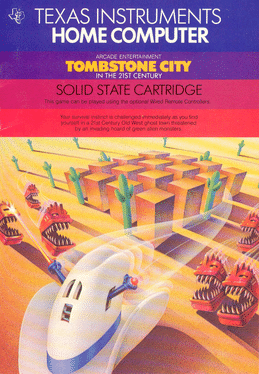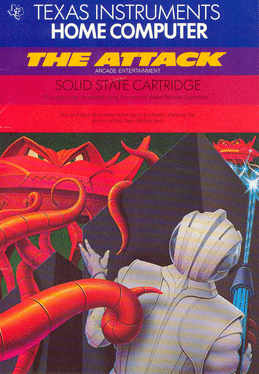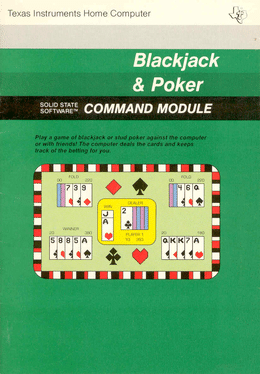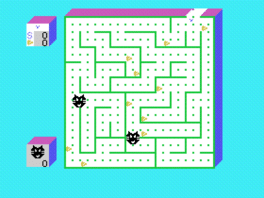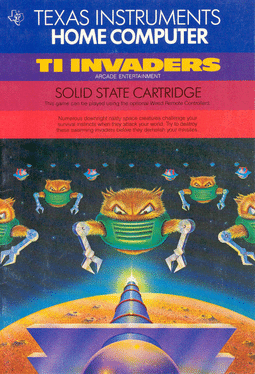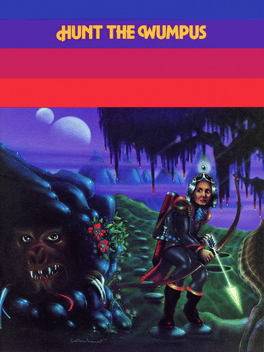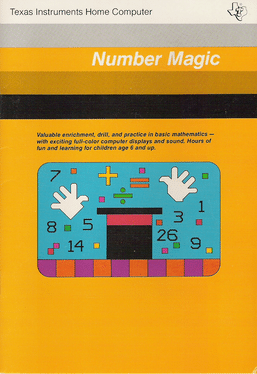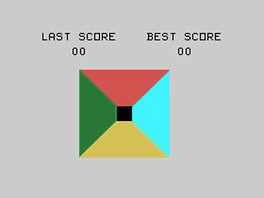New Texas Instruments Ti 99 Games - Page 3
-
Germ Patrol
1983
Germ Patrol
1983
Germ Patrol is a game from Texas Instruments where you must defend the external membrane of a cell from an onslaught of germs as they try and enter. You take the role of a sponge type material which will absorb the germs as they attempt to enter the cell membrane. Once they are caught a germ is counted a captured. If a germ passes through the membrane it is counted as escaped. Who knew germ warfare was so much fun! -
Lobster Bay
1983
Lobster Bay
1983
Lobster Bay is a prototype from Funware which was never released. In Lobster Bay you take the role of a scuba diver in search of missing treasure. You start the game by dismounting from your ship to further dive to greater depths. Along your journey you will encounter Lobsters and Squid. Luckily you have ladders, pipes, ropes, and conveyor belts to help assist you to more treasure. Watch your oxygen level and life count along the way because danger is at every twist and turn. Treasures await below, ahoy! -
Mouse Attack
1983
Mouse Attack
1983
Mouse Attack is a Pac-Man type game where you are the mouse and must navigate through the map to escape the 4 cats on the screen. The path of your character, the mouse, is displayed after each section is crossed. Once the entire map is traced out on the map, the level will end and a new map will start. Mouse Attack! -
Donkey Kong
1983
Donkey Kong
1983
The Texas Instruments TI-99/4A of Donkey Kong was developed by Atari, Inc., under the Atarisoft label. -
Parsec
1982
Parsec
1982
Parsec is a computer game for the Texas Instruments TI-99/4A. Perhaps the best-remembered of all TI-99/4A games, it is a side-scrolling shooter, programmed in 1982 by Jim Dramis (who also programmed the popular TI-99/4A games Car Wars and Munch Man) and Paul Urbanus. The player in Parsec pilots a spaceship through sixteen differently-colored levels of play which scroll horizontally over the screen. The objective is to avoid being shot by an enemy ship, colliding with any flying object and/or the ground, and destroy all enemy ships without overheating one's laser cannon. Three waves of fighters attack, alternating with three waves of cruisers. Enemy ships enter the screen one at a time. A ship flying off the left edge of the screen wraps around to the right side and attacks again. A new fighter can appear with others still on the screen, whereas a new cruiser will not come until the previous one is destroyed. The fighters pose only the threat of collision, while the cruisers fire on the player's ship. The fighter -
Chisholm Trail
1982
Chisholm Trail
1982
Drive your cattle along the famous Chisholm Trail in this top-down arcade-style game. Use the keyboard or joysticks to maneuver your steer around the playing field. But watch out for rustlers who want to steal your cattle, and wranglers who want to put their own brands on your stock. The game features 9 levels of difficulty. -
Munch Man
1982
Munch Man
1982
Munch Man is a video game written by Jim Dramis for the Texas Instruments TI-99/4A home computer and published as a cartridge by Texas Instruments in 1982. Based on Namco's Pac-Man, Munch Man includes several variations that alter and enhance gameplay. Dramis later wrote Parsec for the TI-99/4A. The player controls the Munch Man using either the keyboard or joystick. Like Pac-Man, the goal of a level is to visit every part of the maze, but instead of eating dots the player fills the maze with a chain pattern. Four Hoonos (the equivalent of Pac-Man ghosts) attempt to thwart Munch Man's efforts to complete his mission. However, Munch Man always has his "Energizer" (the equivalent of a Pac-Man power pill) which gives Munch Man the ability to devour the Hoonos. The game ends when the player's lives are depleted. In level 20, 40, and 60, the maze is invisible and there are no chains. Instead, Munch Man must eat all the TI logos in the invisible maze. This gives the odd effect of showcasing the maze at first, but slowl -
Tunnels of Doom
1982
Tunnels of Doom
1982
One of the first graphical computer role-playing games, Tunnels of Doom puts the players in control of up to four characters in a single party, to explore the dangerous Tunnels of Doom, fight monsters, and collect treasure. The four characters can be controlled by one player as a party, or by up to four players, each choosing an action during battles. There are four different character classes available: Fighter, Rogue, Wizard, and Hero. The latter can be selected only if he is the only character in the party. Enemies appear randomly, and the battles are turn-based. Various treasure is scattered around the dungeon; the player also has the option of buying certain equipment. In some places, fountains can be found; drinking from them will affect the party in different ways, positive or negative. -
Alpiner
1982
Alpiner
1982
Alpiner is a third-person action game in which the player's goal is to climb safely to the top of various mountains. Each of the six mountains the player climbs has various obstacles which should be avoided: falling rocks, avalanches, wild animals, trees, and brush fires can all hinder progress. Being hit by these obstacles will cause the player to lose progress, falling down part of the mountain (some obstacles cause a short falling distance, others a long distance). Should the player fall all of the way to the bottom of the mountain a life will be lost. To help anticipate obstacles, voice synthesis provide a warning when danger is near. Each mountain has a time limit in which it must be climbed, though the timer only counts down when the climber isn't moving. As the player progresses through the levels the mountains become higher and obstacles become faster and more numerous. -
Submarine Battle
1982
Submarine Battle
1982
Submarine Battle is a poorer version of the Atari Classic Combat but without the variety. In this game you are a submarine shooting boats and planes as they attempt to locate and destroy your submarine. Sea material is also found in the water making this even more challenging. This game disappoints on so many different levels. Watch out for the Commies! -
Tombstone City: 21st Century
1981
Tombstone City: 21st Century is a single-player multidirectional shooter written by John C. Plaster for TI-99/4A home computer and published by Texas Instruments in 1981. -
Car Wars
1981
Car Wars
1981
In this combination racing game and maze game, you have to maneuver your race car around the track, clearing the dots from all five lanes. The catch is, there's another car (controlled by the computer) driving around the track, in the opposite direction, bent on stopping you. You have to be quick with the lane changes, or the computer car will crash into you. You start with three cars, and can gain extra cars by clearing all the dots from the track. But watch out! The computer adds an an additional opponent on the third round, and another every second round after that! -
Tombstone City
1981
Tombstone City
1981
"One of the best TI99/4A games ever!" - Chris Forrest Aliens called "Morgs" are invading the old west. You must destroy them by shooting them from your "schooner". When you kill them, they turn into cactuses which create obstacles on the map. But if you kill a Morg while it is adjacent to an existing cactus, the Morg and the cactus are both eliminated from the map. Tombstone City was known as Saguaro City in Prototype but was later changed. TI released the source code to this game as part of its Editor/Assembler package. -
The Attack
1981
The Attack
1981
Originally called "Alien Attack," this game pits the player against alien "spores." Although the spores themselves are harmless, they can join together to form giant aliens that chase you down and eat you. To make matters more interesting, scattered around the playing field are a number of "incubators," which can hatch either more spores or, at later levels (or in early levels, in more advanced difficulty levels), more aliens. Use your ship's weapons to blast the spores before they can make new aliens, and blast any aliens before they can devour you. -
Blackjack and Poker
1981
Blackjack and Poker
1981
Card games and computers seem to go hand-in-hand. TI's offering, Blackjack & Poker, allows you to play Blackjack or Stud Poker against the computer, or with up to three other players. The Blackjack game has most of the features of real Blackjack, except for the "split" option. The Stud Poker game pits you against three other players (human, computer or both), and follows the rules for 5-Card Stud. Will you break the bank, or lose your shirt? Only Lady Luck knows for sure! -
A-Maze-Ing
1981
A-Maze-Ing
1981
As the name implies, A-Maze-Ing is a maze game, but with a twist: you control a mouse who has to make its way through an actual maze. Options include "Cheese Hunt" (collect 10 pieces of cheese in the right order before you are shown the exit), "Escape Maze" (Get to the exit as fast as you can), "Mouseholes" (shortcuts through the maze walls) or "Obstacles" (which blocks the center of the passages), whether there are cats (and how many) in the maze, how fast they are, and whether the cats are smart or dumb. Try to beat your own best time, or play with another player choosing between co-operative or competitive play. -
TI Invaders
1981
TI Invaders
1981
TI Invaders is a clone of the game Space Invaders and features similar gameplay. You control a canon at the bottom of the screen, and need to destroy the rows of bomb-dropping invaders! The invaders march back and forth on the screen; each time the edge of the screen is reached, they drop a row closer towards the bottom. If they reach the bottom of the screen before you destroy them, the game will be over. Destroy all the invaders, and you move on to the next, more difficult level. Occasionally, a flying saucer will appear at the top of the screen; this can be shot for bonus points. Between levels you will also have an opportunity to earn bonus points by shooting the saucer as many times as possible before it flies off the screen. -
Hunt the Wumpus
1980
Hunt the Wumpus
1980
The TI-99 game is rather different, it eschews being text-based in favor of a graphical side view. -
Number Magic
1979
Number Magic
1979
Number Magic is an educational game designed to teach young children arithmetic. It is based around a stage magic theme, and includes many images of rabbits and top hats. Three modes are available. Quick Quiz displays randomly-generated arithmetic questions and the player is scored by correct answers. Comp Quiz allows the user to customize several quiz options, such as enable time limits, choose whether to complete answers or missing numbers, and select custom or randomly-generated questions. Electroflash is similar to Comp Quiz but all of the questions include a specific number and arithmetic operation, chosen by the user. After each quiz, the player can choose to repeat the same quiz, generate a new quiz with the same options, select a new quiz type, or quit. -
Simon Says!
1979
Simon Says!
1979
Simon Says! has four colored portions of a large tile, each producing a particular tone when activated by the device. A round in the game consists of lighting up one or more portions of the time in a random order, after which the player must reproduce that order by pressing the correct color. As the game progresses, the number of color presses increases. Simon is named after the simple children's game of Simon Says, but the gameplay is based on Atari's unpopular Touch Me arcade game from 1974. Simon Says! differs from Touch Me in that the Touch Me buttons were all the same color (black) and the sounds it produced were harsh and grating.
